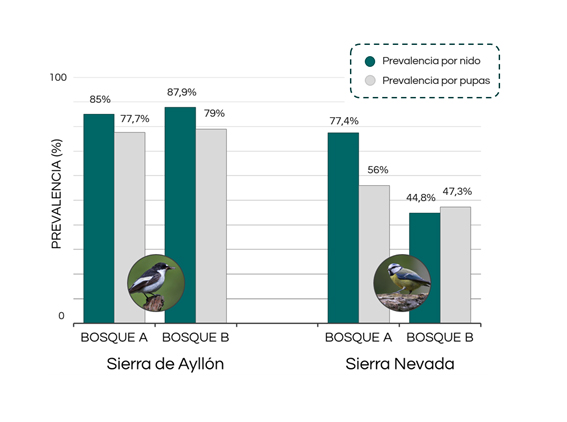Parasitoid wasps may act as hyperparasites and sometimes regulate the populations of their hosts by a top-down dynamic. Nasonia vitripennis is a generalist gregarious parasitoid that parasitizes several host flies, including the blowfly Protocalliphora, which in turn parasitizes bird nestlings. Nonetheless, the ecological factors underlying N. vitripennis prevalence and parasitoidism intensity on its hosts in natural populations are poorly understood. The prevalence of N. vitripennis in Protocalliphora azurea puparia parasitizing wild populations of pied flycatcher Ficedula hypoleuca and blue tit Cyanistes caeruleus birds was studied in two Mediterranean areas in central and southern Spain. Evidence was found that the prevalence of N. vitripennis was higher in moist habitats in southern Spain. A host-dependent effect was found, since the greater the number of P. azurea puparia, the greater the probability and rate of parasitoidism by the wasp. Results also suggest that N. vitripennis parasitizes more P. azurea puparia in blue tit nests than in pied flycatcher nests as a consequence of a higher load of these flies in the former. Based on the high prevalence of N. vitripennis in P. azurea puparia in nature, this study proposes that this wasp may regulate blowfly populations, with possible positive effects on the reproduction of both bird species. informacion[at]ebd.csic.es: Garrido-Bautista et al. (2019). Variation in parasitoidism of Protocalliphora azurea (Diptera: Calliphoridae) by Nasonia vitripennis (Hymenoptera: Pteromalidae) in Spain. Parasitol Res http://dx.doi.org/10.1007/s00436-019-06553-x
https://link.springer.com/article/10.1007/s00436-019-06553-x

 Las altas temperaturas están provocando que las lagunas y las marismas de Doñana pierdan agua rápidamente
Las altas temperaturas están provocando que las lagunas y las marismas de Doñana pierdan agua rápidamente




